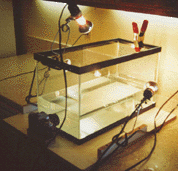

HOW TO BUILD A PHOTOGRAPHIC TORTURE CHAMBER FOR BETTAS (A description of a special tank for getting good clear pictures of bettas)
(Click on Bettas to return to the main betta page or on main site to browse 70 topics ranging from exotic kaleidoscope designs to the strange world of lucid dreaming.)
I'd
like to take credit for developing the system I'm currently using to
take replacement photographs for the poor-quality betta pictures that
are currently on this site. But the truth is the entire design came
from several people who gave me the benefit of their experience. They
are too many to name individually but I thank them all.
I refer to this set up as a torture chamber because the fish don't seem to enjoy it that much.
The problems with taking pictures of bettas are: (1) they move around which makes keeping them in focus difficult; (2) they move around which makes keeping them in the camera's field of view difficult; (3) the bright lights needed for good photos cast reflections off the tank's sides and into the camera; and (4) the background against which the fish are placed can cause annoying reflections and provide the wrong color or brightness contrast for a good picture. The following system solves all of those problems.
(1) Keeping them in focus: The range over which an object will be in focus is called depth of field. Anything within this field is sharp, anything further away or closer is blurred. My system solves this problem in two ways: First, the fish are confined in a narrow, 2-inch deep container that sits inside the main tank. The camera's focus is set to the middle of this depth and since its depth of field is greater than two inches, the fish are always in focus. Second, the lights are bright enough that the camera can be stopped down, ensuring that the depth of field is greater than the fish's swimming range.
Photographic flood lights are set up on moveable holders on both sides and over the top of the tank. The amount of light enables very fast f-stops to be used which increases the depth of field so that it covers the entire depth of the holding cell. Using photographic lights ensures the colors are accurate. The moveable fixtures allows the direction of the light sources to be varied so as to light the fish from the most advantageous angles.
(2) Keeping the fish in the camera's field of view: The same holding container that keeps the fish in the camera's depth of field was made so that when the camera is set up at it's closest focus the container limits their swimming to a zone that is completely covered by the camera's viewing angle. Combined with (1) this means that you don't even need to look through the view finder. Once the camera is set up you can be confident that where ever the fish are they will be in the field of view and in focus.
To increase the odds that the fish are flaring, the holding container was made with two adjoining cells. A fish goes in each one so they can see each other.
(3) Reflections: Shine a light on a glass surface in front of a camera and the odds are there'll be a reflection right where you don't want it. Placing the camera lens right up against the glass of a water-filled tank whose depth is the same as the close focus for the camera and having the lights come in from the sides eliminates this problem. For my trusty old Pentax MX 35mm camera with a 50mm lens, a standard 10-gallon tank is perfect.
(4) Backgrounds: I've had otherwise great pictures ruined because the background behind the fish either caused a reflection that made the picture look like a double image or the color or darkness was wrong for good contrast. I solved both problems with cloth strips that line the back of the holding cells. The cloth prevents reflections and I select a color which, when wet, is close to an eighteen-percent gray card.
Here's a picture of what the setup looks like. I'm slowly in the process of learning how to best use it to take new pictures of all my fish to replace the ones already posted on this site. I find I get the sharpest photographs using ASA 400 film and an F-22 aperture at 1/60 of a second. If I'm shooting a dark fish, dropping down to 1/30 of a second to retain the F-22 shutter gives me sharper pictures than F-16 or F-11 at 1/60 of a second.

This picture shows the old Pentax MX camera I've used for years. I decided it was time to move into the modern age so I purchased a Sony DSC-F707, 5.24 megapixal digital camera.

Here's what it looks like. It's made taking in-focus, color-accurate pictures much easier and quicker. The biggest problem I'm having is that to reduce the pictures to a small enough file size so that they don't eat up all the 10MB of space I have for this site, the pictures end up looking soft. I'm trying to figure out how to beat this problem. If you're interested, I've posted a review of this camera on my homepage.